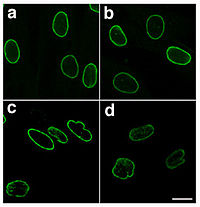
Photo from wikipedia
Associations of chromatin with the nuclear lamina, at the nuclear periphery, help shape the genome in 3 dimensions. The genomic landscape of lamina-associated domains (LADs) is well characterized, but much… Click to show full abstract
Associations of chromatin with the nuclear lamina, at the nuclear periphery, help shape the genome in 3 dimensions. The genomic landscape of lamina-associated domains (LADs) is well characterized, but much remains unknown on the physical and mechanistic properties of chromatin conformation at the nuclear lamina. Computational models of chromatin folding at, and interactions with, a surface representing the nuclear lamina are emerging in attempts to characterize these properties and predict chromatin behavior at the lamina in health and disease. Here, we highlight the heterogeneous nature of the nuclear lamina and LADs, outline the main 3-dimensional chromatin structural modeling methods, review applications of modeling chromatin-lamina interactions and discuss biological insights inferred from these models in normal and disease states. Lastly, we address perspectives on future developments in modeling chromatin interactions with the nuclear lamina.
Journal Title: Frontiers in Cell and Developmental Biology
Year Published: 2022
Link to full text (if available)
Share on Social Media: Sign Up to like & get
recommendations!